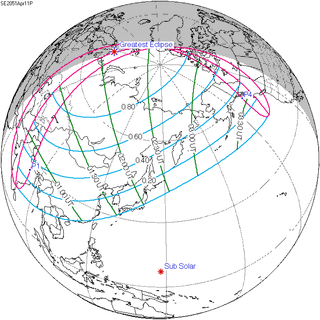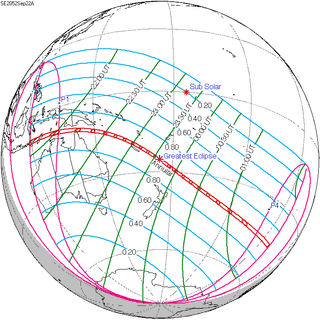Solar eclipse of April 11, 2051
| Solar eclipse of April 11, 2051 | |
|---|---|
 Map | |
| Type of eclipse | |
| Nature | Partial |
| Gamma | 1.0169 |
| Magnitude | 0.9849 |
| Maximum eclipse | |
| Coordinates | 71°36′N 32°12′E / 71.6°N 32.2°E |
| Times (UTC) | |
| Greatest eclipse | 2:10:39 |
| References | |
| Saros | 120 (63 of 71) |
| Catalog # (SE5000) | 9621 |
A partial solar eclipse will occur on April 11, 2051. The umbral shadow of the moon will pass just above the north pole of the earth.
Related eclipses
Solar eclipses 2051-2054
Each member in a semester series of solar eclipses repeats approximately every 177 days and 4 hours (a semester) at alternating nodes of the Moon's orbit.
| 120 | April 11, 2051 Partial |
125 | October 4, 2051 Partial |
| 130 | March 30, 2052 Total |
135 | September 22, 2052 Annular |
| 140 | March 20, 2053 Annular |
145 | September 12, 2053 Total |
| 150 | March 9, 2054 Partial |
155 | September 2, 2054 Partial |
Saros 120
It is a part of Saros cycle 120, repeating every 18 years, 11 days, containing 71 events. The series started with partial solar eclipse on May 27, 933 AD, and reached an annular eclipse on August 11, 1059. It was a hybrid event for 3 dates: May 8, 1510, through May 29, 1546, and total eclipses from June 8, 1564, through March 30, 2033. The series ends at member 71 as a partial eclipse on July 7, 2195. The longest duration of totality was 2 minutes, 50 seconds on March 9, 1997.[1]
Series members 55–65 occur between 1901 and 2100:
| 55 | 56 | 57 |
|---|---|---|
 January 14, 1907 |
 January 24, 1925 |
 February 4, 1943 |
| 58 | 59 | 60 |
 February 15, 1961 |
 February 26, 1979 |
 March 9, 1997 |
| 61 | 62 | 63 |
 March 20, 2015 |
 March 30, 2033 |
 April 11, 2051 |
| 64 | 65 | |
 April 21, 2069 |
 May 2, 2087 |
References
| Wikimedia Commons has media related to Solar eclipse of 2051 April 11. |

